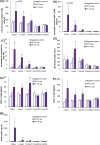Investigation of pulmonary inflammatory responses following intratracheal instillation of and inhalation exposure to polypropylene microplastics
- PMID: 39107780
- PMCID: PMC11301944
- DOI: 10.1186/s12989-024-00592-8
Investigation of pulmonary inflammatory responses following intratracheal instillation of and inhalation exposure to polypropylene microplastics
Abstract
Background: Microplastics have been detected in the atmosphere as well as in the ocean, and there is concern about their biological effects in the lungs. We conducted a short-term inhalation exposure and intratracheal instillation using rats to evaluate lung disorders related to microplastics. We conducted an inhalation exposure of polypropylene fine powder at a low concentration of 2 mg/m3 and a high concentration of 10 mg/m3 on 8-week-old male Fischer 344 rats for 6 h a day, 5 days a week for 4 weeks. We also conducted an intratracheal instillation of polypropylene at a low dose of 0.2 mg/rat and a high dose of 1.0 mg/rat on 12-week-old male Fischer 344 rats. Rats were dissected from 3 days to 6 months after both exposures, and bronchoalveolar lavage fluid (BALF) and lung tissue were collected to analyze lung inflammation and lung injury.
Results: Both exposures to polypropylene induced a persistent influx of inflammatory cells and expression of CINC-1, CINC-2, and MPO in BALF from 1 month after exposure. Genetic analysis showed a significant increase in inflammation-related factors for up to 6 months. The low concentration in the inhalation exposure of polypropylene also induced mild lung inflammation.
Conclusion: These findings suggest that inhaled polypropylene, which is a microplastic, induces persistent lung inflammation and has the potential for lung disorder. Exposure to 2 mg/m3 induced inflammatory changes and was thought to be the Lowest Observed Adverse Effect Level (LOAEL) for acute effects of polypropylene. However, considering the concentration of microplastics in a real general environment, the risk of environmental hazards to humans may be low.
Keywords: Inhalation exposure; Intratracheal instillation; Microplastics; Polypropylene; Pulmonary toxicity; Rat.
© 2024. The Author(s).
Conflict of interest statement
The authors declare that they have no known competing financial interests or personal relationships that could have appeared to influence the work reported in this paper.
Figures






References
-
- OECD. Global Plastics Outlook. 2022.
-
- Zhang Y, Kang S, Allen S, Allen D, Gao T, Sillanpää M. Atmospheric microplastics: a review on current status and perspectives. Earth-Sci Rev. 2020;203:103118.10.1016/j.earscirev.2020.103118 - DOI
-
- Yao X, Luo X-S, Fan J, Zhang T, Li H, Wei Y. Ecological and human health risks of atmospheric microplastics (MPs): a review. Environ Sci Atmos. 2022;2:921–42.10.1039/D2EA00041E - DOI
-
- Sarathana D, Winijkul E. Concentrations of airborne microplastics during the dry season at five locations in Bangkok metropolitan Region, Thailand. Atmosphere (Basel). 2022;14:28.10.3390/atmos14010028 - DOI
Publication types
MeSH terms
Substances
Grants and funding
LinkOut - more resources
Full Text Sources
Medical
Research Materials
Miscellaneous

